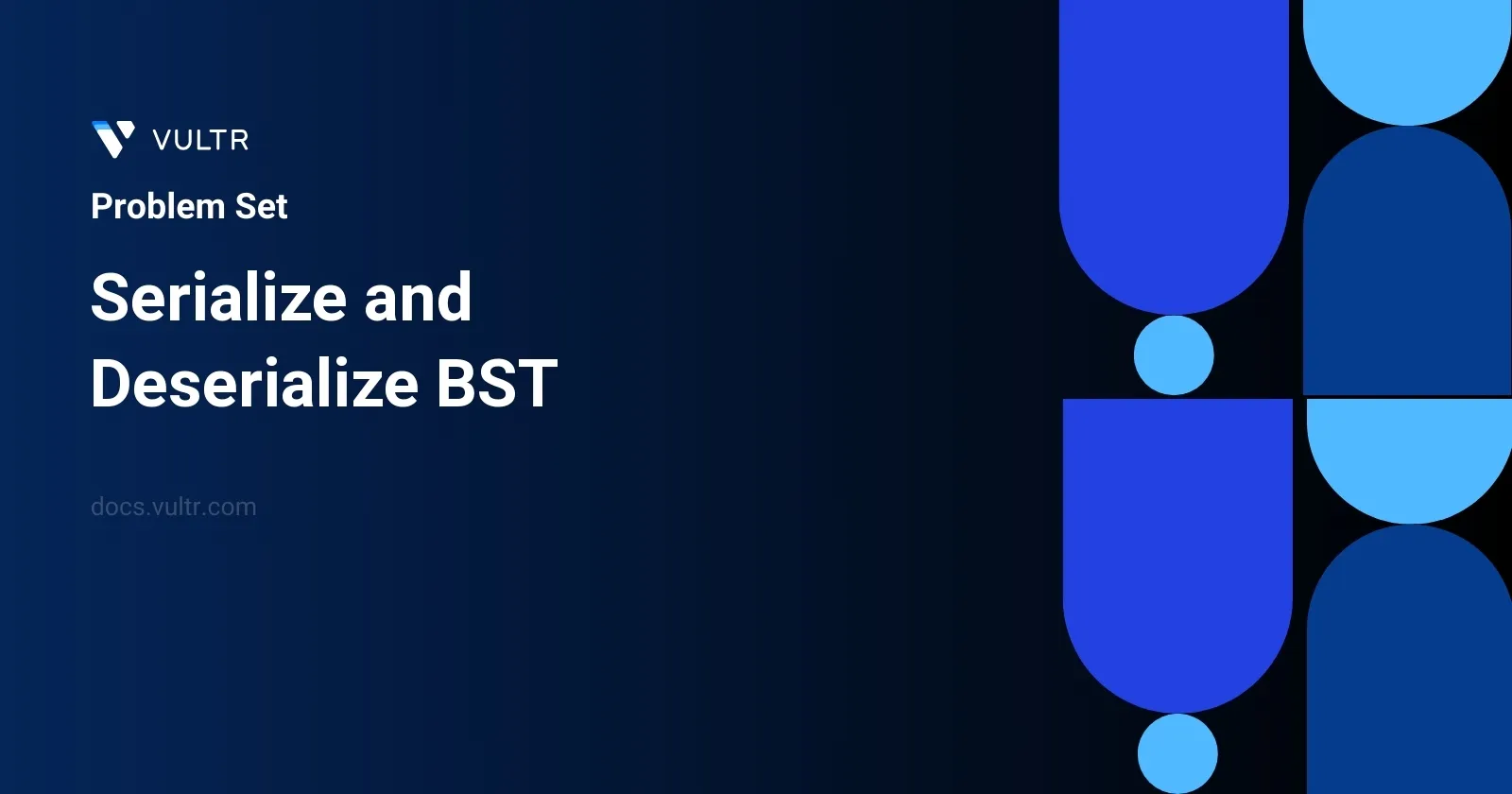
Problem Statement
In computer science, serialization involves converting a data structure or object into a sequence of bits to facilitate storage in a file, memory buffer, or to transmit across a network so that it can be reconstructed later in the same or another computing environment. In the context of this problem, the goal is to develop an algorithm capable of both serializing and deserializing a binary search tree (BST). Serialization should transform the BST into a compact string form while deserialization should revert this string back into the original BST structure. The design of the algorithm is not restricted, but the solution should emphasize achieving the most compact string representation possible.
Examples
Example 1
Input:
root = [2,1,3]
Output:
[2,1,3]
Example 2
Input:
root = []
Output:
[]
Constraints
- The number of nodes in the tree is in the range
[0, 104]. 0 <= Node.val <= 104- The input tree is guaranteed to be a binary search tree.
Approach and Intuition
Given that the purpose is to serialize and deserialize a binary search tree, let's delve into a typical approach and intuition:
Understanding Binary Search Trees (BSTs):
- BSTs have the property where the left child node's value is less than the parent node's value and the right child node's value is greater. This property is pivotal because it ensures that each element in the tree is uniquely placed based on its value.
Serialization Approach:
- To serialize the BST, you can use several methods, such as pre-order, in-order, post-order traversal, or level-order traversal. However, for reconstructing the BST exactly, using pre-order or post-order traversal is often the most straightforward approach because these methods record the root's position early.
- In pre-order traversal, the root is processed before the left and right subtrees, which helps in maintaining the hierarchy of the tree during deserialization.
- A compact form of serialization can be achieved by separating node values with a delimiter, like commas, and using a specific character, such as 'N', to denote null values (empty nodes).
Deserialization Approach:
- Deserialization involves reconstructing the BST from the serialized string. If pre-order traversal was used for serialization, the string can be split by its delimiters, and a recursive function can be employed that takes the list of node values (and indices for bounds) to recreate the tree.
- Given that we know the properties of BST and have the root value (from the serialized string's starting value in the case of pre-order serialization), the tree can be recursively rebuilt by inserting nodes such that they retain the BST properties.
Using the examples provided as a reference:
Example 1:
- The BST with root as
[2,1,3]when serialized may look like2,1,3using pre-order. - Deserialization would involve reading
2as root, placing1on the left of2, and3on the right, correctly reconstructing the tree.
- The BST with root as
Example 2:
- An empty tree
[]would straightforwardly serialize to an empty string and vice versa.
- An empty tree
Constraints ensure that node values and the count are within manageable limits and the architecture operates within these defined parameters, guaranteeing a BST as input for correct functionality.
Solutions
- Java
public class TreeCodec {
public void encodeTree(TreeNode node, StringBuilder output) {
if (node == null)
return;
encodeTree(node.left, output);
encodeTree(node.right, output);
output.append(convertIntToString(node.val));
}
public String convertIntToString(int number) {
char[] characters = new char[4];
for (int i = 3; i >= 0; i--) {
characters[3 - i] = (char) ((number >> (i * 8)) & 0xFF);
}
return new String(characters);
}
public String createSerializedData(TreeNode node) {
StringBuilder serializedData = new StringBuilder();
encodeTree(node, serializedData);
return serializedData.toString();
}
public TreeNode buildTreeFromList(Integer lowerBound, Integer upperBound, ArrayDeque<Integer> numbers) {
if (numbers.isEmpty())
return null;
int value = numbers.getLast();
if (value < lowerBound || value > upperBound)
return null;
numbers.removeLast();
TreeNode rootNode = new TreeNode(value);
rootNode.right = buildTreeFromList(value, upperBound, numbers);
rootNode.left = buildTreeFromList(lowerBound, value, numbers);
return rootNode;
}
public int parseStringToInt(String valueStr) {
int parsedValue = 0;
for (char b : valueStr.toCharArray()) {
parsedValue = (parsedValue << 8) + (int) b;
}
return parsedValue;
}
public TreeNode decodeStringToTree(String encodedData) {
ArrayDeque<Integer> integerValues = new ArrayDeque<Integer>();
int size = encodedData.length();
for (int i = 0; i < size / 4; i++) {
integerValues.add(parseStringToInt(encodedData.substring(4 * i, 4 * i + 4)));
}
return buildTreeFromList(Integer.MIN_VALUE, Integer.MAX_VALUE, integerValues);
}
}
The Java program provided serializes and deserializes a Binary Search Tree (BST) using a custom data format. The solution involves two primary components: serializing a BST into a string format and deserializing the string back to a BST. Here's a breakdown of the process:
Serialization:
- The
encodeTreemethod performs a postorder traversal of the tree (visiting left subtree, right subtree, and then the node itself). - Each node's integer value is converted to a 4-byte string via the
convertIntToStringmethod, which processes each byte of the integer separately and appends them to form a string. - The entire tree gets translated into a single string by appending each node’s processed value to a
StringBuilderobject in thecreateSerializedDatamethod.
- The
Deserialization:
- The
decodeStringToTreemethod first converts the serialized string data back into integers. It processes every 4 characters (bytes) of the input string to reconstruct each original integer value of the nodes usingparseStringToInt. - These integers are stored in an
ArrayDeque. - Using the
buildTreeFromListfunction, the method reconstructs the tree. This function picks numbers from the deque recursively and constructs the tree by assigning integer values to the appropriate left and right child nodes based on the BST properties.
- The
Overall, the code efficiently handles the conversion of a BST to a byte-oriented string representation and vice versa, using bitwise operations and postorder traversal, which are suitable for capturing a tree's structure especially when maintaining hierarchy and null relationships is essential.